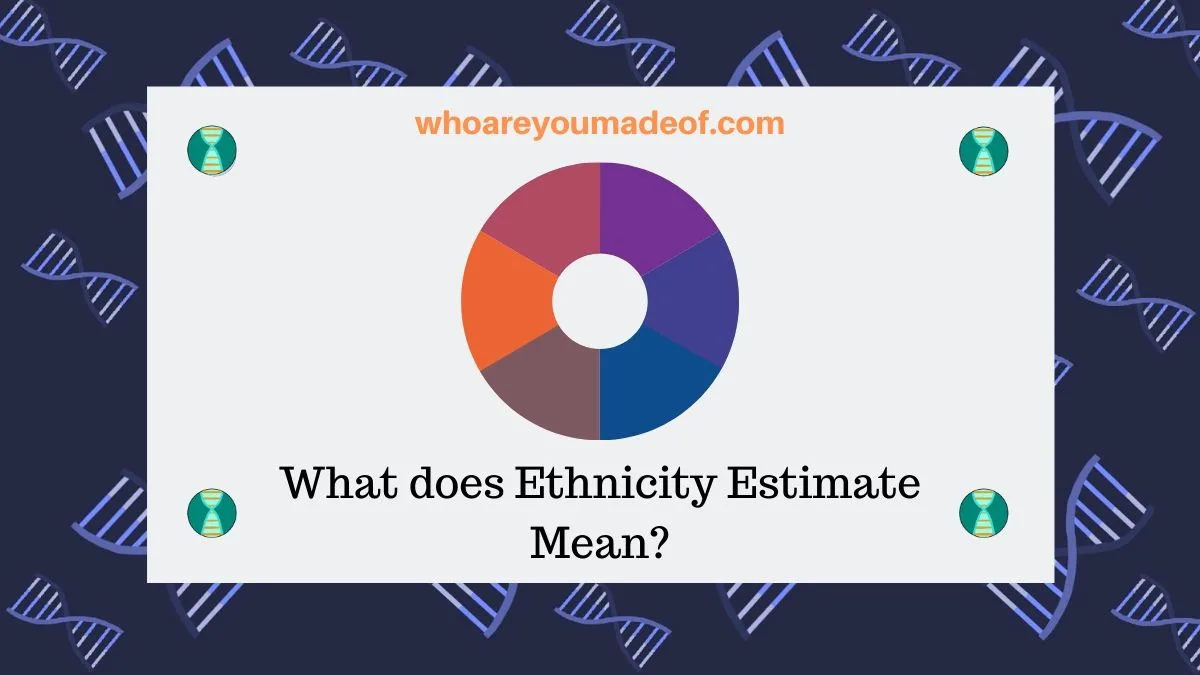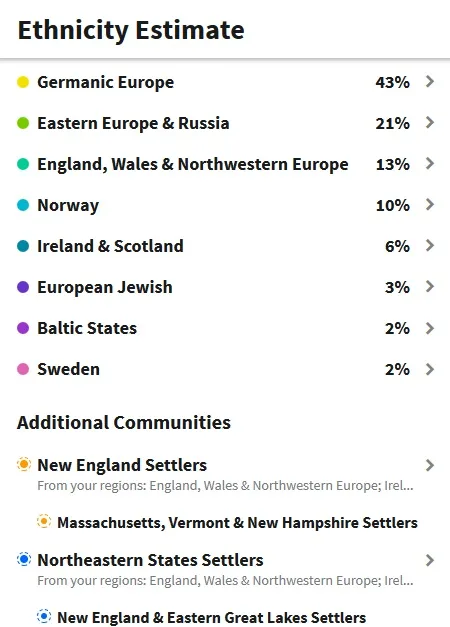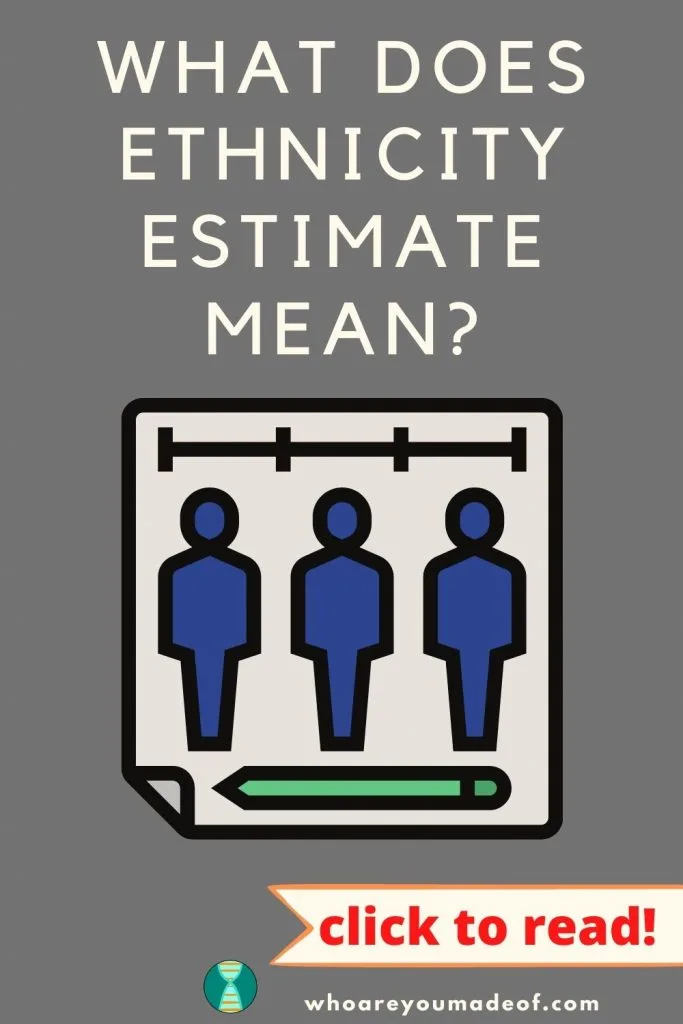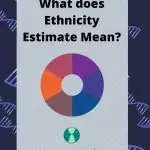Have you heard of an ethnicity estimate? Did you get one in your DNA results? This post will help you understand what an ethnicity estimate means, as well as:
- What is an ethnicity estimate
- How to understand the DNA ancestry percentage breakdown
- Whether DNA ethnicity estimates can tell us about all of our ancestors
- Whether ethnicity estimates are accurate
- How to get an ethnicity estimate test

Ethnicity estimates are the most popular reason that people do DNA tests, and are the main reason that DNA testing has grown in popularity. In fact, when most people refer to their DNA results, they are usually referring to their ancestry or ethnicity estimate!
So, what does ethnicity estimate mean?
An ethnicity estimate is an estimate of the likely historical origins of your ancestors. People all over the world live in communities of people that identify with each other culturally and linguistically, and these groups of communities of people are often referred to as “ethnicities”.
It’s important to know that “ethnicity” isn’t the same as how the word “race” is used. Plus, most scientists agree that there is no scientific evidence that race even exists – it’s just a (bad) social idea that humans have developed over time.
Since people with a common linguistic, cultural, geographical and historical heritage have tended to live together throughout history, minor differences in their DNA have evolved. These tiny, tiny differences are, in the grand scheme of things, relatively insignificant.
These super tiny differences do make “ethnicity estimates” or ancestry estimates possible, however.
Even though each human being is 99.9% identical to any other human, scientists have been able to identify markers in the .1% that is different that can pinpoint where our ancestors likely lived.
The end result is an ethnicity estimate, also called an ancestry composition report or ancestry estimate, as seen below:

How to understand the DNA ancestry percentage breakdown
Each DNA testing company has developed their own software algorithm to determine the ethncities that should show up on our estimates. They develop these algorithms using DNA samples collected from thousands of people who have deep ancestry in one of dozens of regions around the world.
When we submit our sample, they compare our DNA with reference panels that they developed using these sample populations. They then assign as much of our DNA as possible to the region that it matches most closely.
For example, we can see from the image above that I show 43% Germanic Europe DNA on my estimate. This means that 43% of my DNA most closely matches the Germanic Europe region.
This does not mean that 43% of my ancestors were from Germanic Europe, however. While I obviously do have lots of ancestors from Germanic Europe, what the results are really telling me is that 43% of the DNA that I inherited from my parents matches the Germanic Europe region.
I inherited 50% of my mother’s DNA and 50% of my father’s DNA. From the 43% Germanic Europe result, I can’t tell which parent I inherited it from.
Additionally, without testing my parents, I would have no way to know what type of ethnicity information was contained in the DNA that I didn’t inherit from them. Remember, I only inherited 50% of their DNA, so there is another 50% that they have that could reveal some very interesting information.
It’s important to understand, therefore, that the ethnicity estimate does a pretty good job telling us about the DNA that we did inherit from our ancestors, but it is certainly not a thorough examination of all of our ancestors. Instead, it’s a complementary tool that, along with our DNA matches, can help us build a family tree.
Are ethnicity estimates accurate?
Even though the science of DNA testing and estimating ethnicity is still developing, we consider ethnicity estimates to be fairly accurate. Despite what people may say, they are not “guesses” about our ancestry.
Most of the problems that people encounter with their ethnicity estimates are due to misunderstandings about how DNA is inherited. Additionally, we don’t really know where our ancestors’ ancestors were from, so they may have had DNA from regions that would be a surprise to us.
For example, an recent e-mail from a reader comes to mind. They were surprised to find Eastern European DNA in their results, even though all of their recent ancestors were verified to have been born in Italy.
Occasionally, DNA testing algorithms can mistake one region in our DNA for another nearby region. While uncommon, we see it most in regions that are close in geographic proximity (i.e. Sweden vs. Norway).
It is very uncommon to find ethnicity estimates with results that have regions that are incorrect at the continent level.
How to get an ethnicity estimate test
There are several excellent companies that offer DNA tests that provide you with an ethnicity estimate. While I have tested with and recommend multiple companies, my favorites are Ancestry DNA and 23andMe.
Each of the companies in the links below offers a very similar DNA testing experience, and you will receive a high-quality ethnicity estimate along with DNA matches with each test result.
You can order a DNA test using any of the links below. I may receive a very small commission that helps me support this site, and it is at no extra cost to you, so thank you!
Your DNA results will contain much more than just an ethnicity estimate!
Not everyone realizes that their DNA results have many elements. All of the major DNA testing companies listed above provide DNA matches, and some of the companies have extra features, too. For example, 23andMe provides maternal and paternal haplogroups along with DNA results.
If you do decide to do a DNA test for ethnicity, there will be lots to explore in your results.
Conclusion
I first got my ethnicity estimate three years ago. It has been a lot of fun to explore my ancestry this way, and I have been fascinated to see how it has updated over time based on new research and technology.
I hope that this post has helped you understand more about what ethnicity estimates mean, how to understand them, and whether they are accurate. If you would like to share your own experience with these estimates, or if you have questions about something that you read in this post, I would love to hear from you in the discussion below.
Thank you for stopping by today!



